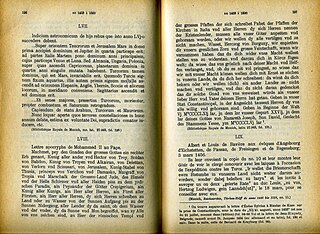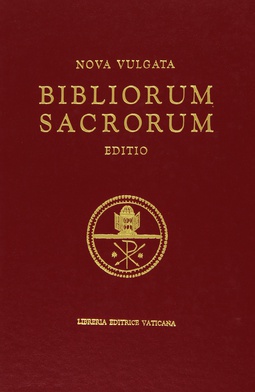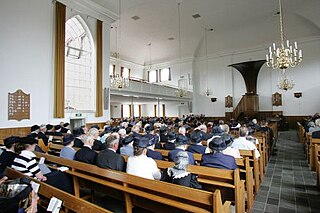Related Research Articles

Apocrypha are written works, often of unknown authorship or doubtful origin. In Christianity, the word apocryphal (ἀπόκρυφος) was first applied to writings which were to be read privately rather than in the public context of church services -- edifying Christian works which were not considered canonical Scripture. In the wake of the Protestant Reformation, the word apocrypha came to mean "false, spurious, bad, or heretical".

The Bible is a collection of religious texts or scriptures that are held to be sacred in Christianity, Judaism, Samaritanism, and many other religions. The Bible is an anthology – a compilation of texts of a variety of forms – originally written in Hebrew, Aramaic, and Koine Greek. These texts include instructions, stories, poetry, and prophecies, among other genres. The collection of materials that are accepted as part of the Bible by a particular religious tradition or community is called a biblical canon. Believers in the Bible generally consider it to be a product of divine inspiration, but the way they understand what that means and interpret the text can vary.

The New Testament (NT) is the second division of the Christian biblical canon. It discusses the teachings and person of Jesus, as well as events in first-century Christianity. The New Testament's background, the first division of the Christian Bible, is called the Old Testament, which is based primarily upon the Hebrew Bible; together they are regarded as sacred scripture by Christians.
Sola scriptura, meaning by scripture alone, is a Christian theological doctrine held by most Protestant Christian denominations, in particular the Lutheran and Reformed traditions of Protestantism, that posits the Bible as the sole infallible source of authority for Christian faith and practice. The Catholic Church considers it heterodox and generally the Orthodox churches consider it to be contrary to the 'phronema' of the Church.

Textus Receptus refers to all printed editions of the Greek New Testament from Erasmus's Novum Instrumentum omne (1516) to the 1633 Elzevir edition. It was the most commonly used text type for Protestant denominations.

The Bible has been translated into many languages from the biblical languages of Hebrew, Aramaic, and Greek. As of September 2022 all of the Bible has been translated into 724 languages, the New Testament has been translated into an additional 1,617 languages, and smaller portions of the Bible have been translated into 1,248 other languages according to Wycliffe Global Alliance. Thus, at least some portions of the Bible have been translated into 3,589 languages.

Biblical inerrancy is the belief that the Bible "is without error or fault in all its teaching"; or, at least, that "Scripture in the original manuscripts does not affirm anything that is contrary to fact". Some equate inerrancy with biblical infallibility; others do not.

The Nova Vulgata, also called the Neo-Vulgate, is the official Classical Latin translation of the original-language texts of the Bible published by the Holy See. It was completed in 1979, and was promulgated the same year by John Paul II in Scripturarum thesaurus. A second, revised edition was published in 1986. It is the official Latin text of the Bible of the Catholic Church. The Nova Vulgata is also called the New Latin Vulgate or the New Vulgate.

Biblical inspiration is the doctrine in Christian theology that the human writers and canonizers of the Bible were led by God with the result that their writings may be designated in some sense the word of God. This belief is traditionally associated with concepts of the biblical infallibility and the internal consistency of the Bible.
Bruce Manning Metzger was an American biblical scholar, Bible translator and textual critic who was a longtime professor at Princeton Theological Seminary and Bible editor who served on the board of the American Bible Society and United Bible Societies. He was a scholar of Greek, New Testament, and New Testament textual criticism, and wrote prolifically on these subjects. Metzger was one of the most influential New Testament scholars of the 20th century. He was elected to the American Philosophical Society in 1986.

Reformed fundamentalism arose in some conservative Presbyterian, Congregationalist, Reformed Anglican, Reformed Baptist, Non-denominational and other Reformed churches, which agrees with the motives and aims of the broader evangelical Protestant fundamentalism. The movement was historically defined by a repudiation of liberal and modernist theology, the publication (1905-1915) entitled, The Fundamentals, and had the intent to progress and revitalise evangelical Protestantism in predominantly English-speaking Protestant countries, as well as to reform separated churches according to the Bible, historic expression of faith and the principles of the Reformation. The Fundamentalist–Modernist controversy, and the Downgrade controversy, kindled the growth and development of reformed fundamentalism in the United States and the United Kingdom. Reformed fundamentalists have laid greater emphasis on historic confessions of faith, such as the Westminster Confession of Faith. Sixteenth century Reformers such as John Calvin, Martin Luther, John Knox, Theodore Beza, Philip Melanchthon and Protestant ministers such as Matthew Henry, John Gill, John Bunyan, George Whitefield, Jonathan Edwards, Charles Spurgeon, J. C. Ryle, John Burgon, F. B. Meyer, Dwight L. Moody, George Müller and G. Campbell Morgan have shaped the leaders in this reformed tradition.
In contrast to the variety of absolute or personal names of God in the Old Testament, the New Testament uses only two, according to the International Standard Bible Encyclopaedia.

The New Testament in the Original Greek is a Greek-language version of the New Testament published in 1881. It is also known as the Westcott and Hort text, after its editors Brooke Foss Westcott (1825–1901) and Fenton John Anthony Hort (1828–1892). Textual scholars use the abbreviations "WH" or "WHNU". It is a critical text, compiled from some of the oldest New Testament fragments and texts that had been discovered at the time.

A biblical manuscript is any handwritten copy of a portion of the text of the Bible. Biblical manuscripts vary in size from tiny scrolls containing individual verses of the Jewish scriptures to huge polyglot codices containing both the Hebrew Bible (Tanakh) and the New Testament, as well as extracanonical works.

The Old Testament is the first section of the two-part Christian biblical canon; the second section is the New Testament. The Old Testament includes the books of the Hebrew Bible (Tanakh) or protocanon, and in various Christian denominations also includes deuterocanonical books. Orthodox Christians, Catholics and Protestants use different canons, which differ with respect to the texts that are included in the Old Testament.

A biblical canon is a set of texts which a particular Jewish or Christian religious community regards as part of the Bible.

The canon of the New Testament is the set of books many modern Christians regard as divinely inspired and constituting the New Testament of the Christian Bible. For historical Christians, canonization was based on whether the material was from authors socially approximate to the apostles and not based solely on divine inspiration – however, many modern scholars recognize that the New Testament texts were not written by apostles. For most, it is an agreed-upon list of 27 books that includes the canonical Gospels, Acts, letters attributed to various apostles, and Revelation, though there are many textual variations. The books of the canon of the New Testament were written before 120 AD. Although the list of what books constituted the canon differed among the hundreds of churches in antiquity, according to ancient church historian Eusebius there was a consensus that the same 27 books constituting the canon today were the same 27 books generally recognized in the first century. For the Orthodox, the recognition of these writings as authoritative was formalized in the Second Council of Trullan of 692. The Catholic Church provided a conciliar definition of its biblical canon in 382 at the (local) Council of Rome as well as at the Council of Trent of 1545, reaffirming the Canons of Florence of 1442 and North African Councils of 393–419. For the Church of England, it was made dogmatic on the Thirty-Nine Articles of 1563; for Calvinism, on the Westminster Confession of Faith of 1647.

Textual criticism of the New Testament is the identification of textual variants, or different versions of the New Testament, whose goals include identification of transcription errors, analysis of versions, and attempts to reconstruct the original text. Its main focus is studying the textual variants in the New Testament.
The Bible-Presbyterian Church ("BPC") was a conservative reformed denomination in Singapore. It existed from 1955 to 1988, following the history of the country, as the Bible-Presbyterian Church of Malaya, then the Bible-Presbyterian Church of Singapore and Malaysia, and finally the Bible Presbyterian Church of Singapore ("BPCOS") before the BPCOS dissolved in 1988. Since that time, Bible-Presbyterian churches in Singapore have continued to exist separately. The B-P movement grew out of the Bible Presbyterian Church in the United States. As of 2009, there were 20,000 members in 32 B–P churches in Singapore. The number of B-P churches in Singapore has grown to forty-three as of 2020/21.
In Protestant theology, verbal plenary preservation (VPP) is a doctrine concerning the nature of the Bible. While verbal plenary inspiration ("VPI") applies only to the original autographs of the Bible manuscript, VPP views that, "the whole of Scripture with all its words even to the jot and tittle is perfectly preserved by God in the apographs without any loss of the original words, prophecies, promises, commandments, doctrines, and truths, not only in the words of salvation, but also the words of history, geography and science; and every book, every chapter, every verse, every word, every syllable, every letter is infallibly preserved by the Lord Himself to the last iota so that the Bible is not only infallible and inerrant in the past, but also infallible and inerrant today ."
References
- ↑ Paolo Sacchi - The History of the Second Temple Period A&C Black, 2004. Chapter 2 - The Jewish Culture of the Sixth Century BCE. Page 91.
- ↑ Definition of apograph - plural apographa Merriam-Webster.
- ↑ Identification Of God's Preserved Words (I) - Inspiration, Preservation, and Translations: In Search of the Biblical Identity of the Bible-Presbyterian Church Archived 2018-01-01 at the Wayback Machine - Lesson 8. B. Autographs Only or Apographs Also? truthbpc.com.
- ↑ Dr. Jeffrey Khoo - SOLA AUTOGRAPHA OR SOLA APOGRAPHA? A CASE FOR THE PRESENT PERFECTION AND AUTHORITY OF THE HOLY SCRIPTURES - Dean Burgon Society. Retrieved 31 May 2017.
- ↑ A. J. MacDonald, Jr. - The Ecclesiastical Text [ permanent dead link ] - wordpress.com.
- ↑ Bruce M. Metzger, The Text of the New Testament: Its Transmission, Corruption, and Restoration, p. 136.
- ↑ Bruce M. Metzger - A Textual Commentary on the Greek New Testament, Second Edition (companion to the UBS Greek NT)